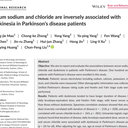Tonic Electromyogram Density in Multiple System Atrophy with Predominant Parkinsonism and Parkinson's Disease.
الكلمات الدالة
نبذة مختصرة
BACKGROUND
Both Parkinson's disease (PD) and multiple system atrophy (MSA) have associated sleep disorders related to the underlying neurodegenerative pathology. Clinically, MSA with predominant parkinsonism (MSA-P) resembles PD in the manifestation of prominent parkinsonism. Whether the amount of rapid eye movement (REM) sleep without atonia could be a potential marker for differentiating MSA-P from PD has not been thoroughly investigated. This study aimed to examine whether sleep parameters could provide a method for differentiating MSA-P from PD.
METHODS
This study comprised 24 MSA-P patients and 30 PD patients, and they were of similar age, gender, and REM sleep behavior disorder (RBD) prevalence. All patients underwent clinical evaluation and one night of video-polysomnography recording. The tonic and phasic chin electromyogram (EMG) activity was manually quantified during REM sleep of each patient. We divided both groups in terms of whether they had RBD to make subgroup analysis.
RESULTS
No significant difference between MSA-P group and PD group had been found in clinical characteristics and sleep architecture. However, MSA-P patients had higher apnea-hypopnea index (AHI; 1.15 [0.00, 8.73]/h vs. 0.00 [0.00, 0.55]/h, P = 0.024) and higher tonic chin EMG density (34.02 [18.48, 57.18]% vs. 8.40 [3.11, 13.06]%, P < 0.001) as compared to PD patients. Subgroup analysis found that tonic EMG density in MSA + RBD subgroup was higher than that in PD + RBD subgroup (55.04 [26.81, 69.62]% vs. 11.40 [8.51, 20.41]%, P < 0.001). Furthermore, no evidence of any difference in tonic EMG density emerged between PD + RBD and MSA - RBD subgroups (P > 0.05). Both disease duration (P = 0.056) and AHI (P = 0.051) showed no significant differences during subgroup analysis although there was a trend toward longer disease duration in PD + RBD subgroup and higher AHI in MSA - RBD subgroup. Stepwise multiple linear regression analysis identified the presence of MSA-P (β = 0.552, P < 0.001) and RBD (β = 0.433, P < 0.001) as predictors of higher tonic EMG density.
CONCLUSIONS
Tonic chin EMG density could be a potential marker for differentiating MSA-P from PD.




